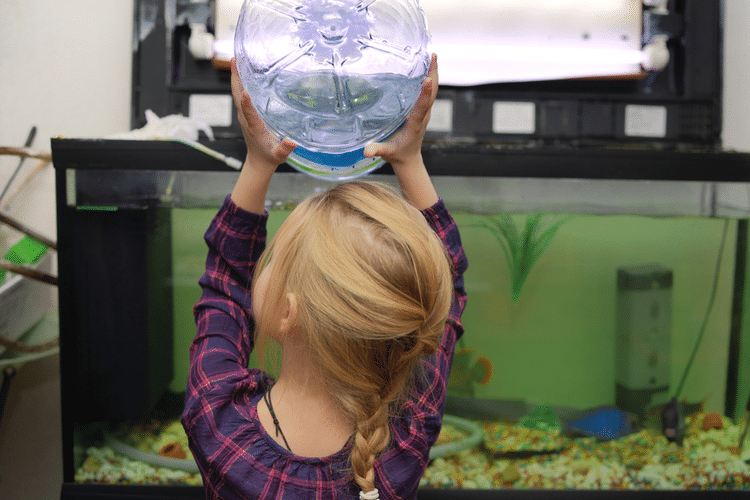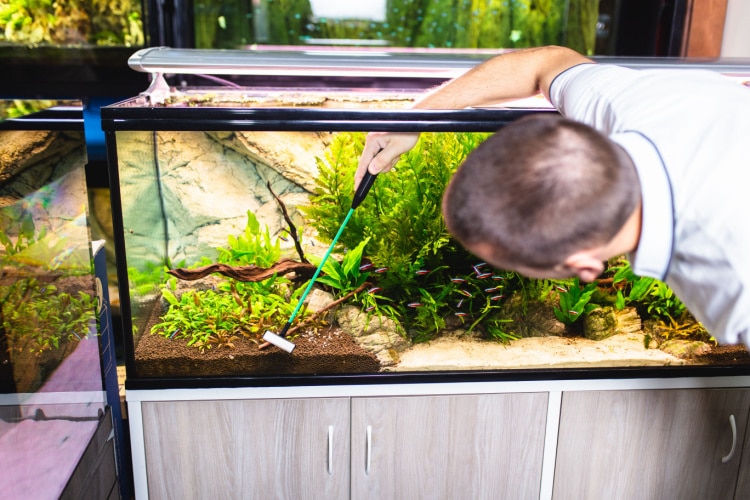Anyone that’s kept fish can probably attest to the fact that they are underrated pets, as it’s very satisfying to care for them and watch them grow. However, it’s also widely acknowledged that maintaining a healthy aquatic environment for these creatures requires significant effort and attention.
The main aspect of this maintenance is the careful management of the water environment. A large part of that depends on selecting the appropriate type of water because that can greatly impact the health and well-being of the inhabitants.
In this article, we will explore the potential benefits and drawbacks of using reverse osmosis water for fish tank aquariums and assist you in determining if it is a viable option for the your fish tank aquarium.
What Are The Benefits of Reverse Osmosis Water for Aquarium?
The main benefit of using reverse osmosis water in an aquarium is that RO water is free from pollutants and chemicals that makes it difficult for fishes to thrive in aquariums. For example, fishes are extremely sensitive to chlorine, chlorine byproducts, nitrates, and other similar chemicals commonly found in tap water. To make the water capable of sustaining aquatic life, you need to filter it or treat it. Alternatively, you can use distilled or filtered water, which is basically what reverse osmosis water is.

Since it has already been through a thorough filtration process, RO water provides a much more suitable base for your aquarium than tap water, although you’ll still need to balance the pH value and do a few additional measures (discussed below).
Additionally, while most reverse osmosis systems cost between several hundred and several thousand dollars, you also have the option to buy reverse osmosis bottled water from the store or get it from a distillery. The average price for bottled RO water is around $1 a gallon and around $0.5 a gallon if you get it from an RO water dispensary.
What Are The Downsides of Reverse Osmosis Water in Aquariums?
The only major downside to using reverse osmosis water in your aquarium is that the filtration process removes minerals from the water along with the contaminants.
The reverse osmosis filtration process doesn’t distinguish between good or bad minerals. If the molecules are too large for the screen, they’re removed. This is great if the water in your area is particularly rich in iron or sodium since fish can’t survive in water that’s oversaturated with minerals. However, they still need a bit of magnesium and calcium to live, so the water can’t be completely dKind Water Systemsid of them either.
To make the water habitable for them, you’ll need to remineralize the ro water.
How to Use Reverse Osmosis Water in Aquariums
Now that we’ve gone over the pros and cons of reverse osmosis water, it’s time to move on to the practical application of using it in your aquarium.
1. Get the Right Fish
The first step is getting the right fish. We know this seems obvious, but you’d be surprised at how often people put freshwater fish in a saltwater tank and vice-versa.
Reverse osmosis water should only be used in freshwater fish tanks. There are fish that require salt water to live, and there are fish that require brackish water. These are three very different types of environments with very different preparation, so ensure that you’re only putting freshwater fish in your tank with RO water.
Additionally, different fish also have different mineral requirements. Hard water is rich in calcium and magnesium, and so-called hard water fish, such as cichlids and certain types of rainbow fish, need a high concentration of minerals to survive.
We do realize that this is a lot of homework, but you need to ensure that all of your fish are capable of tolerating the same environment since that’s going to determine your next steps.

2. Clean the Tank
As we’ve established, fish are sensitive. Their environments need to be controlled and maintained very precisely. This means that the best way to get started would be to clean the tank of any germs or stains.
We suggest using non-toxic chemicals or cleaning solutions since they’re much easier to dissolve. Using commercial washing products is fine, but you need to ensure that the tank is thoroughly rinsed out afterward and that there aren’t any traces of cleaning chemicals left on the tank’s walls.
Our advice would be to use a solution that’s one part white vinegar and two parts water. Mix the vinegar solution into a spray bottle and clean the inside of your tank. White vinegar removes most stains, is non-toxic, and rinses out very easily.
Once the tank has been cleaned, let it dry for a bit, then go over the inside walls with a cloth to ensure it’s completely dry.
3. Add Decorations
This is technically the least important yet the most satisfying step and can be done last. That said, we find that it’s much easier to add decorations to your aquarium while it’s still empty.
You can use any sort of ornaments, fake trees, and pirate chests that you want, but we’d advise against coating the bottom with regular sand or rocks.
More specifically, you shouldn’t use sand, rocks, or dirt that you picked up yourself. If you want to coat the bottom of your tank, the best option is to get sterile sand and rocks designed for fish tanks.
These items can be found in just about any pet shop, and while they’ll cost a bit more than regular sand or rocks, they won’t have any contaminants or potentially dangerous substances on them.
4. Prepare and Add the RO Water
Once the tank is ready, it’s time to add the reverse osmosis water and get things ready for your fishy friends.
When it comes to aquariums, you need to monitor three things: general hardness, carbonate hardness, and pH levels. General hardness (GH) measures the mineral content of the water, while carbonate hardness (KH) measures the carbonate and bicarbonate levels. The pH levels depend on the first two factors, so you’ll need to adjust those to get the right pH level for your fish.
Once you know which fish you will put in your tank, you should look up the optimal pH value for them. You’ll also need a pH reader in your tank at all times, so we’d suggest getting a filter with a built-in reader and temperature gauge.
GH and KH will need to be measured manually, using a home testing kit. Luckily, these values won’t shift much unless you add chemicals to the water, so you only need to check them once every two weeks or so.
Similarly to the pH value, you’ll need to look up your fish’s GH and KH values. If the GH value needs to be higher, add a bit of mineral-rich limestone to the fish tank, and if the KH value needs to be increased, add a bit of sodium carbonate or bicarbonate.
Add these substances in small increments since you can always add more, but you can’t reduce them if you add too much at once.
Once the GH and KH values are within the proper range, check the pH value. It should also be within the optimal parameters for all of your fish. If it isn’t, then adding a bit of calcium carbonate can increase the sodium levels and get it to the right spot on the reader.
5. Finishing Touches
Once the tank, the decorations, and the water are ready, it’s time to add your fish to the aquarium.
If you follow our instructions and the GH, KH, and pH values are as they should be, then there shouldn’t be any problems when you bring in your fish.
After you add the fish to the tank, all that’s left is to do the standard aquarium maintenance procedures. Some of these include making sure that the filter is working properly, scrubbing the glass for algae every once in a while, and cycling out a portion of the water weekly.
Conclusion
Reverse osmosis water makes a much better base for aquariums than regular tap water. It’s already purified and doesn’t contain any nitrates, sulfates, or harmful chemicals, and you only need to remineralize it if you want to use it in your aquarium.
If getting a reverse osmosis system just for your aquarium is out of your budget, you can buy bottled RO water from a shop or get some online.
After you get the water, all that’s left is to add it to the tank, add a few chemicals to make it ready for your fish, and place your aquatic pets inside the tank.